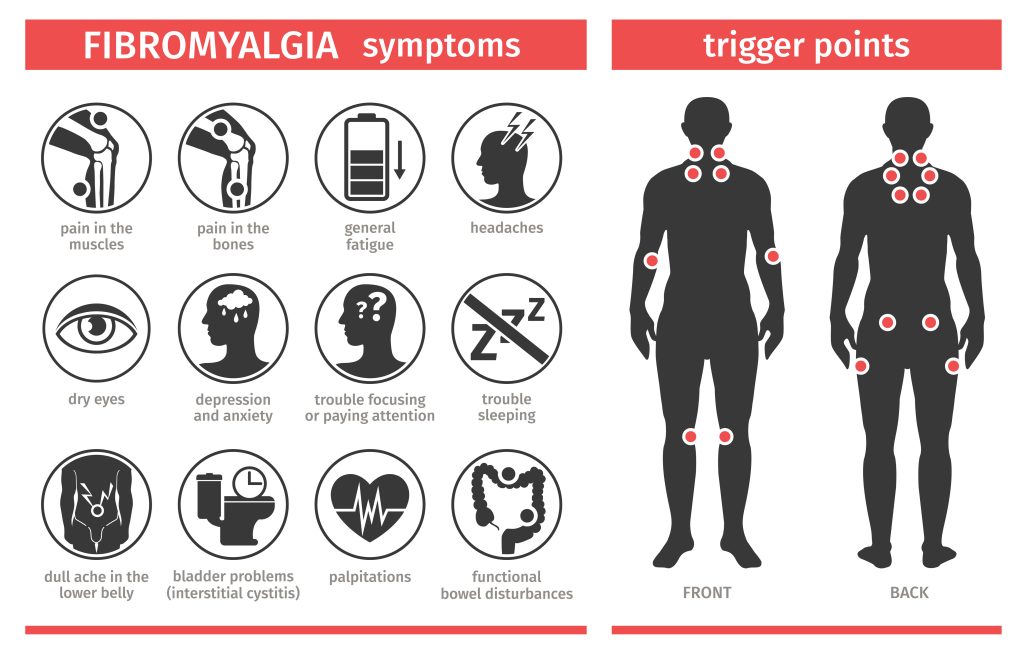If you’ve heard the word fibromyalgia and felt confused, you’re not alone. Even many people living with it struggle to explain what it is. This blog is here to help you—and those who care about you—easily understand fibromyalgia.
Fibromyalgia in Simple Terms
Fibromyalgia is a long-term condition that causes widespread pain and tenderness throughout the body, often accompanied by fatigue, poor sleep, and “fibro fog”—a term for the memory and concentration problems many people experience.
Unlike an injury or arthritis, fibromyalgia doesn’t damage your joints or muscles. Instead, it’s a problem with how the nervous system processes pain signals. Think of it like a volume knob for pain that’s turned up too high. Everyday sensations that shouldn’t hurt can feel painful, and real pain can feel amplified.
Common Symptoms
Fibromyalgia symptoms vary from person to person, but the most common include:
- Widespread pain: A deep, aching pain on both sides of the body, above and below the waist.
- Fatigue: Feeling exhausted even after a full night’s sleep.
- Sleep problems: Trouble falling or staying asleep, or waking up unrefreshed.
- Cognitive issues (“fibro fog”): Difficulty focusing, remembering, or thinking clearly.
- Other symptoms: Headaches, irritable bowel syndrome, jaw pain (TMJ), anxiety, and depression.

Causes of Fibromyalgia
There is no evidence of any disease process or injury, but research shows it involves changes in the brain and spinal cord that increase pain sensitivity. This is called central sensitisation. This over sensitisation, is created by the brain, which is likely playing the major role of generating and contributing to the ongoing symptoms. These are called neuroplastic symptoms.
Fibromyalgia often starts after a triggering event—such as an infection, injury, surgery, or major stress—but sometimes it develops gradually. Genetics can play a role, too.
The pain comes from a nervous system that’s stuck in “high alert” mode, not from damaged tissues. That’s why standard scans and blood tests often look normal—even though the pain is very real.
There is Hope.
Conventional treatment currently promotes a narrative of no single “cure,” however, this model is outdated and fails to acknowledge the origins of hypersensitivity in the nervous system and the importance of safety as a driver for the condition. Often treatment is directed towards the symptoms and emotions as a consequence of the condition, as opposed to recognising the importance of emotional dysregulation as a driver for the problem. Fibromyalgia is treatable and complete resolution has been reported through lived experience reports. The research will follow. Many people improve significantly with the right combination of:
- Education: Understanding the condition reduces fear and stress.
- Gentle mindful movement: Activities like walking, yoga, or tai chi calm the nervous system.
- Stress reduction: Understanding, mindfulness, breathing exercises, and emotional awareness and expression help reduce nervous system sensitivity.
- Targeted therapies: pain reprocessing therapy, journaling and sometimes medication can all play a role.
With the right support, life with fibromyalgia can get better—and full resolution is an option.
For more information checkout these websites:
If you would like help with starting your recovery, our specialist pain physiotherapists are members of SIRPA and use pain reprocessing therapy as part of their toolkit. Email [email protected] for more information, or call us on 0131 478 4646 for more information.


